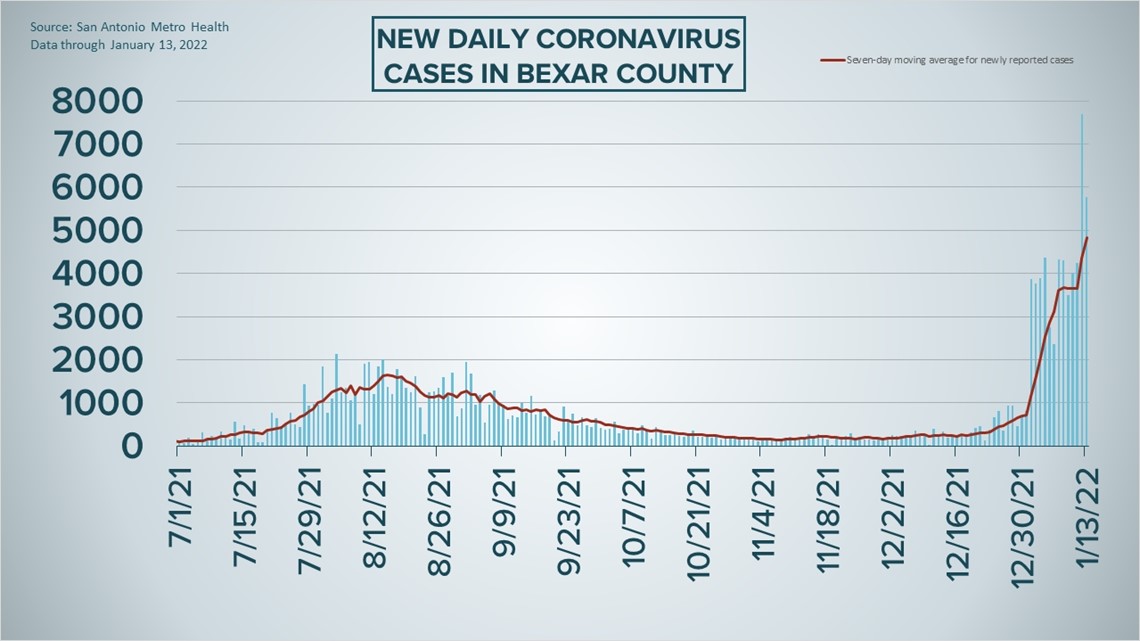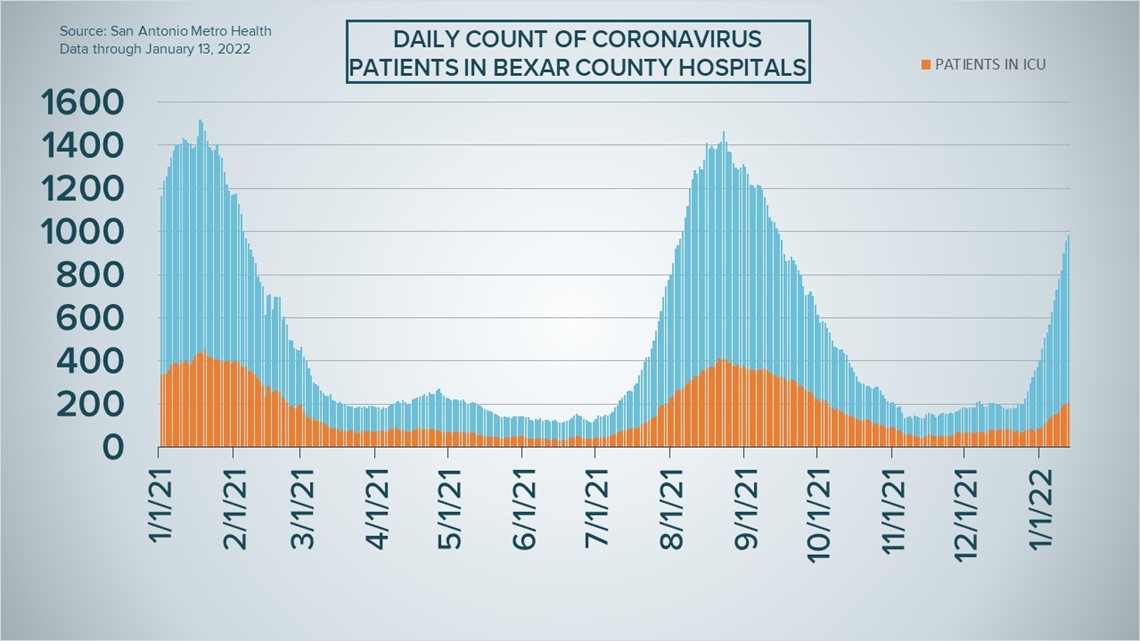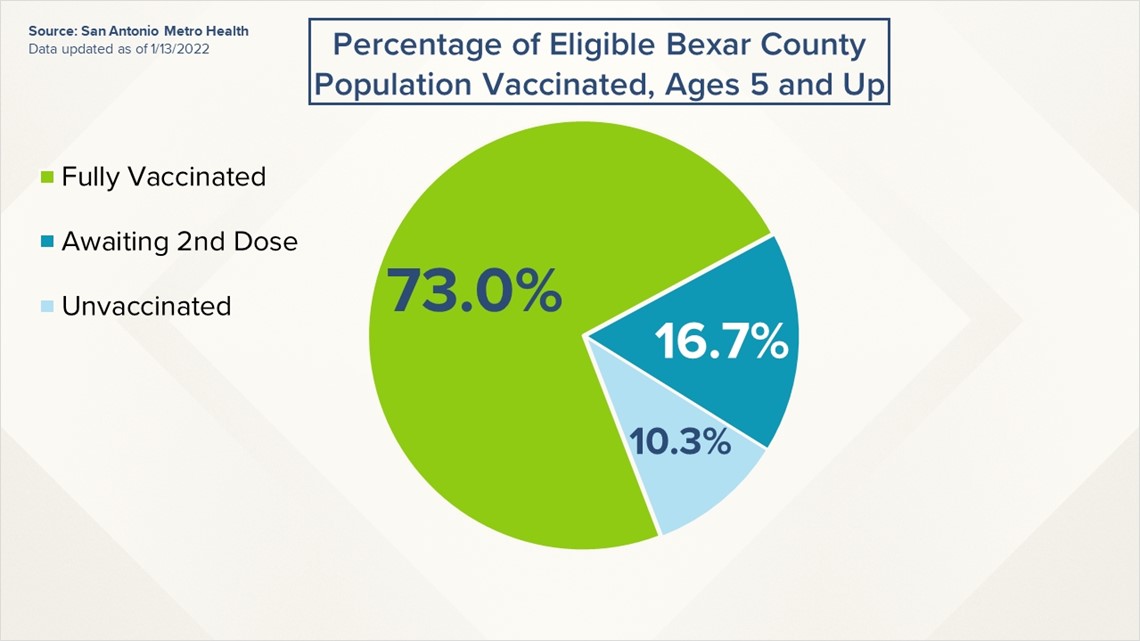SAN ANTONIO — Bexar County health authorities recorded the area's second-highest count of new COVID-19 cases in the ongoing pandemic on Thursday, tallying 5,781 new diagnoses a day after reporting a record-shattering figure of more than 7,700.
The development comes as the San Antonio area continues to wrestle with the contagious omicron variant, which has exacerbated the most drastic spike of cases the community has seen over the last two years. In all, 395,180 county residents have been diagnosed with the coronavirus, while the seven-day average of new cases rose to a new record-high of 4,841.
Health authorities recorded just one day of more than 3,000 new cases in all of 2021. So far, it's happened 11 times this year.
Metro Health officials also reported that nine additional Bexar County residents have died from virus-related complications, the highest single-day count since October and a figure that pushes the county's death toll past 5,000, to 5,006.
COVID-19 test administrators told KENS 5 the number of residents they're testing increased dramatically in the first week of the year, playing a factor in the new wave of cases. New testing sites have continued to open across the city this week, although Metro Health warned on Monday that residents could see delays in getting their results.
The number of local coronavirus hospitalizations, meanwhile, went up for a 20th straight day on Thursday, this time to 982. September 15 was the last time the number was that high, but UT researchers predict that they'll soar higher in our area and across Texas in the next couple weeks.
Of those 982 local patients, 206 are in intensive care and 73 are on ventilators.
How Bexar County is trending




Vaccine Progress in Bexar County
The following numbers are provided by San Antonio Metro Health. A full breakdown can be found here.
- 1.699 million eligible Bexar County residents have received at least one dose of the coronavirus vaccine as of Thursday, Jan. 13, representing 89.7% of the county's population eligible (those over the age of 4) to receive a vaccination.
- 1.383 million eligible Bexar County residents are fully vaccinated as of Thursday, Jan. 13, representing 73% of the county's population eligible to receive a vaccination.


The CDC states that "when a high percentage of the community is immune to a disease (through vaccination and/or prior illness)," that community will have reached herd immunity, "making the spread of this disease from person to person unlikely."
The City of San Antonio breaks down the vaccination rates by zip code on Metro Health's Vaccination Statistics page.
Coronavirus in Texas
The total number of coronavirus cases in the state since the pandemic began grew by 74,491 on Thursday, according to the Texas Department of State Health Services, the second-highest amount recorded by the state. That total includes 59,268 new confirmed cases and 15,223 new probable cases. More details can be found on this page.
Thursday's figures bring the total number of Texans diagnosed with COVID-19 to more than 5.297 million.
An additional 117 Texans have died from virus complications, meanwhile, raising the statewide death toll to 75,650.
Coronavirus symptoms
The symptoms of coronavirus can be similar to the flu or a bad cold. Symptoms include fever or chills, cough, shortness of breath or difficulty breathing, fatigue, muscle or body aches, headache, new loss of taste or smell sore throat, congestion or runny nose, nausea or vomiting, and diarrhea, according to the Centers for Disease Control.
Most healthy people will have mild symptoms. A study of more than 72,000 patients by the Centers for Disease Control in China showed 80 percent of the cases there were mild.
But infections can cause pneumonia, severe acute respiratory syndrome, kidney failure, and even death, according to the World Health Organization. Older people with underlying health conditions are most at risk.
Experts determined there was consistent evidence these conditions increase a person's risk, regardless of age:
- Chronic kidney disease
- COPD (chronic obstructive pulmonary disease)
- Obesity (BMI of 30 or higher)
- Immunocompromised state (weakened immune system) from solid organ transplant
- Serious heart conditions, such as heart failure, coronary artery disease, or cardiomyopathies
- Sickle cell disease
- Type 2 diabetes
- The CDC believes symptoms may appear anywhere from two to 14 days after being exposed.
Human coronaviruses are usually spread...
- Between people who are in close contact with one another (within about 6 feet).
- Through respiratory droplets produced when an infected person coughs, sneezes or talks. These droplets can land in the mouths or noses of people who are nearby or possibly be inhaled into the lungs.
- Some recent studies have suggested that COVID-19 may be spread by people who are not showing symptoms.
Help stop the spread of coronavirus
- Stay home when you are sick.
- Eat and sleep separately from your family members
- Use different utensils and dishes
- Cover your cough or sneeze with your arm, not your hand.
- If you use a tissue, throw it in the trash.
Find a Testing Location
City officials recommend getting a COVID-19 test if you experience fever or chills, cough, shortness of breath or difficulty breathing, fatigue, muscle or body aches, headache, new loss of taste or smell, sore throat, congestion or runny nose, nausea or vomiting, or diarrhea.
Here's a Testing Sites Locator to help you find the testing location closest to you in San Antonio.
Latest Coronavirus Headlines
- Supreme Court halts COVID-19 vaccine-or-test rule for large businesses, keeps health care worker mandate
- Biden to double free COVID tests, add N95s, to fight omicron
- Texas could double its COVID-19 hospitalization record, models say
- More mass COVID-19 testing sites coming to San Antonio
- If you have these COVID tests at home, stop using them, FDA says
- When am I contagious if infected with omicron?
- This San Antonio school district purchased 250,000 KN95 masks for students, staff
- USPS ready to deliver COVID-19 home test kits, postmaster general says

